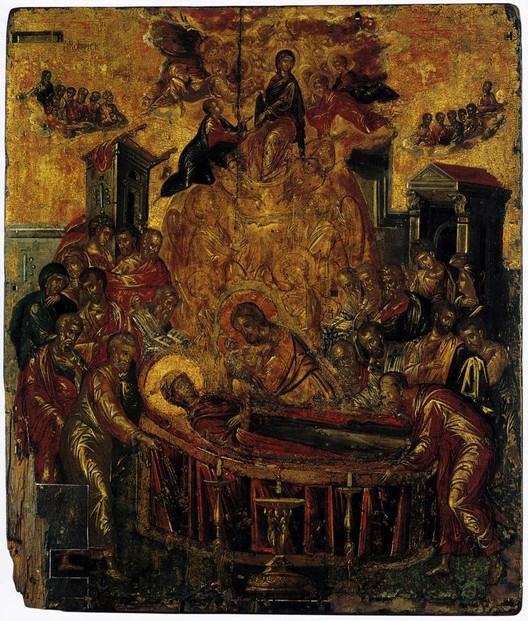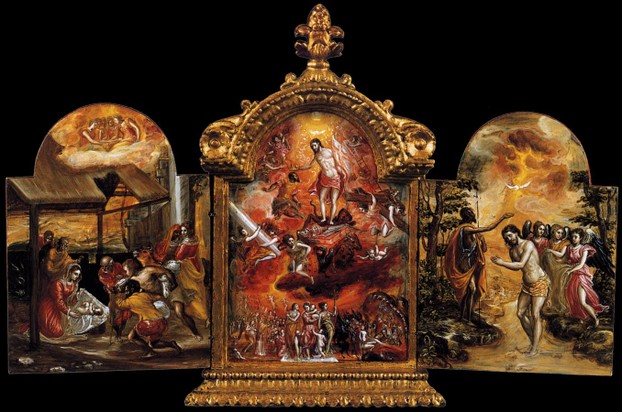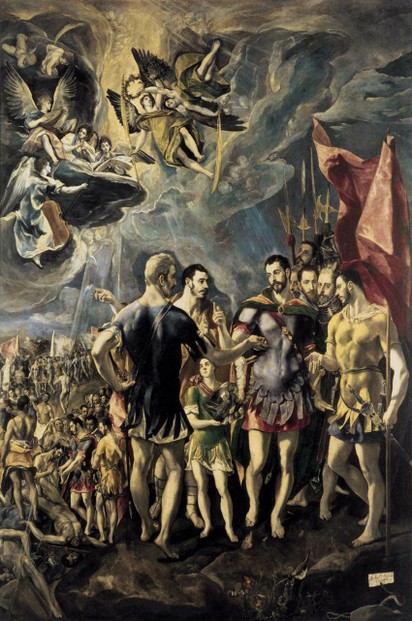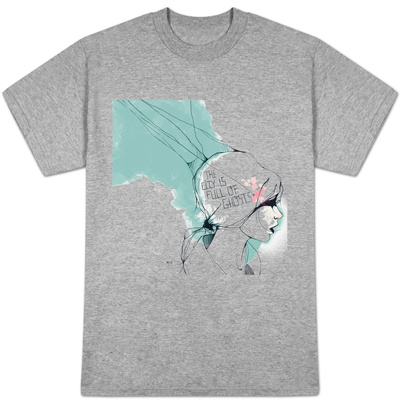Allen, George R. 1984. El Greco: Two Studies. Philadelphia, PA: J.F. Warren.
Álvarez Lopera, José. (Ed.). 1999. El Greco: Identity and Transformation – Crete, Italy, Spain. Madrid, Spain: Museo Thyssen-Bornemisza; Milan, Italy: Skira; New York, NY: Abbeville Publishing Group.
Brown, Jonathan. 1982. El Greco of Toledo: Exhibition Organized by the Toledo Museum of Art, with Museo del Prado, National Gallery of Art, Dallas Museum of Fine Arts. Boston, MA: Little, Brown.
Brown, Jonathan; and Mann, Richard G. 1990. Spanish Paintings of the Fifteenth through Nineteenth Centuries. Washington, D.C.: National Gallery of Art.
Byron, Robert; and Rice, David Talbot. 1968. The Birth of Western Painting: A History of Colour, Form, and Iconography, Illustrated from the Paintings of Mistra and Mount Athos of Giotto and Duccio, and El Greco. Reprint of the 1930 Edition. New York, NY: Hacker Art Books.
Calvo Serraller, Francisco. 1995. El Greco: The Burial of the Count of Orgaz. Translated from the Spanish El Greco: El entierro del conde de Orgaz by Jenifer Wakelyn. New York, NY: Thames and Hudson.
Davies, David. (Ed.). 2003. El Greco: Essays by David Davies and John H. Elliott; Catalogue Entries by Xavier Bray, Keith Christiansen, Gabriele Finaldi with Contributions by Marcus Burke and Lois Oliver. London, England: National Gallery; New Haven, CT: Yale University Press.
"El Greco. Domenikos Theotokopoulos." History and Arts: Fichas > Personajes. Artehistoria Proyectos Digitales, SL. Retrieved October 27, 2014.
- Available at: http://www.historyandarts.com/fichas/personajes/2106.htm
"El Greco Museum." planerGO.com: Spain > Castile-LaMancha > Toledo. Retrieved October 27, 2014.
- Available at: http://planergo.com/en/sights/El-Greco-museum/
"El Greco Museum." Spain Info: Art > Museums. Madrid, Spain: Turespaña / Segittur (Sociedad Estatal para la Gestión de la Innovación y las Tecnologías Turísticas, S.A.). Retrieved October 27, 2014.
- Available at: http://www.spain.info/en/que-quieres/arte/museos/toledo/casa-museo_de_el_greco.html
"El Greco's Toledo." Indian Chief Travel Guides: Spain > Castilla-LaMancha > Toledo. Retrieved October 27, 2014.
- Available at: http://www.indianchieftravel.com/en/spain/castilla-la-mancha/toledo/toledo-spain-3
Gudiol, José. Domenikos Theotokopoulos, El Greco, 1541 – 1614. Translated from the Spanish by Kenneth Lyons. New York, NY: Viking Press, 1973.
Hadjinicolaou, Nicos. 1995. El Greco in Italy and Italian Art. In Greek with English Translation. O Gkreko stin Italia kai i italiki techni / epimeleia, Nikou Chatsēnikolaou. Athens, Greece: Ioniki Trapeza.
Hadjinicolaou, Nicos. 1990. El Greco of Crete: Exhibition on the Occasion of the 450th Anniversary of His Birth. Domēnikos Theotokopoulos Krēs : ekthesē me aphormē ta 450 chronia apo tē gennēsē tou / epimeleia, Nikou Chatsēnikolaou. Iraklion, Crete: Dēmos Ērakleiou.
"Jorge Manuel Theotokopoulos." History and Arts: Fichas > Obras. Artehistoria Proyectos Digitales, SL. Retrieved October 27, 2014.
- Available at: http://www.historyandarts.com/fichas/obras/1712.htm
Kelemen, Pál. 1961. El Greco Revisited: Candia, Venice, Toledo. New York, NY: Macmillan.
Lassaigne, Jacques. 1973. El Greco. English Translation by Jane Brenton. London, England: Thames & Hudson.
Luna, Juan J. 1983. El Greco. Agence France d'Images. Princeton, NJ: Films for the Humanities.
Mann, Richard G. 1989. El Greco and His Patrons: Three Major Projects. Cambridge, England; and New York, NY: Cambridge University Press Studies in the History of Art.
Marías Franco, Fernando. 1991. El Greco. Translated by Jay Hyams. Milan, Italy: Anaya Editoriale; New York, NY: Crescent Books.
Marías Franco, Fernando. 2013. El Greco: Life and Work, A New History. Translated from the Spanish Greco, Historia de un pintor extravagante by Paul Edson and Sander Berg. Donostia-San Sebastián: Nerea; London, England; and New York, NY: Thames & Hudson.
Marías Franco, Fernando. 2001. El Greco in Toledo. London, England: Scala Publishers National Monuments of Spain Series; Madrid, Spain: Aldeasa.
Marías Franco, Fernando. (Ed.). 2014. El Greco of Toledo: Painter of the Visible and the Invisible. Madrid, Spain: Ediciones El Viso.
"Museum of El Greco." Toledo - Travel Guide: Tourist Attractions. Retrieved October 27, 2014.
- Available at: http://www.toledo-travelguide.com/tourist/attractions/museum-of-el-greco.html
"Outline Biography of El Greco (documented facts of his life)." Web Gallery of Art: Tours > Spain > Greco. Retrieved October 27, 2014.
- Available at: http://www.wga.hu/tours/spain/greco1.html
Panagiōtakēs, Nikolaos. 2009. El Greco: The Cretan Years. Translated from the Greek Krētikē periodos tēs zōēs tou Domēnikou Theotokopoulou by John C. Davis. With a Preface by Nicos Hadjinicolaou. Edited by Roderick Beaton. Farnham, U.K.; and Burlington, VT: Ashgate.
Preston, Stuart. 1953. El Greco. 46 Reproductions, Including 12 in Full Color. New York, NY: Beechhurst Press.
Suárez Quevedo, Diego. 2000. «La iglesia de la Santísima Trinidad de Toledo (parroquia de San Marcos) obra de Jorge Manuel Theotocópuli.» Anales Toledanos 61-82.
"Theotocópuli, Jorge Manuel." Museo Nacional del Prado: Enciclopedia > Enciclopedia online. Retrieved October 27, 2014.
- Available at: https://www.museodelprado.es/enciclopedia/enciclopedia-on-line/voz/theotocopuli-jorge-manuel/?no_cache=1
Tomlinson, Janis. 1997. From El Greco to Goya: Painting in Spain 1561 - 1828. Prentice Hall Perspectives Series.
Underwood, Peter. 2009. Haunted Gardens: An International Journey. Stroud, Gloucestershire, England: Amberley Publishing Plc.
Wethey, Harold E. 1962. El Greco and His School. Princeton, NJ: Princeton University Press.
White, K. "El Greco Museum, Toledo, Spain." SpainExchange.com: Spain > Toledo > Museums. Retrieved October 27, 2014.
- Available at: http://www.spainexchange.com/spain/toledo/museums/el-greco-museum
Wismer, Beat; and Scholz-Hünsel, Michael. (Eds.). 2012. El Greco and Modernism. Ostfildern, Germany: Hatje Cantz Verlag.



















 Are Hawaiian Huakai Po Nightmarchers Avenging Halloween Thursday?on 10/02/2024
Are Hawaiian Huakai Po Nightmarchers Avenging Halloween Thursday?on 10/02/2024
 Mailing Addresses for 2023 Form 4868 Extending 1040 and 1040SR April 15, 2024, Due Dateon 04/15/2024
Mailing Addresses for 2023 Form 4868 Extending 1040 and 1040SR April 15, 2024, Due Dateon 04/15/2024
 Mailing Addresses for 2023 Forms 1040 and 1040SR Filed in 2024on 04/15/2024
Mailing Addresses for 2023 Forms 1040 and 1040SR Filed in 2024on 04/15/2024
 Mailing Addresses for 2022 Form 4868 Extending 1040 and 1040SR April 18, 2023, Due Dateon 04/13/2023
Mailing Addresses for 2022 Form 4868 Extending 1040 and 1040SR April 18, 2023, Due Dateon 04/13/2023



Comments
The Blogger author Brunet collects compelling considerations in Doña Jerónima de las Cuevas, Mujer de El Greco ("Doña Jerónima de las Cuevas, wife/woman of El Greco") Thursday, Nov. 23, 2017.
The afore-designated article describes Jerónima as possibly Antequeruela-brothel prostitute, Jewish, married to El Greco, perishing during or subsequent to childbirth, romanced by a non-Christian El Greco. It mentions her prostitution as the only motive for her mysterious non-roles and roles.
Might there be another motivation?
Let's imagine that The Beautiful Lady at the Haunted Gardens of the El Greco House and Museum in Toledo Spain and the Two Ghosts Who Haunt the Royal Botanical Garden Across From the Westin Hotel Palace in Madrid, Spain itinerate to interact.
When might they meet? El Día de los Muertos (the Day of the Dead)?
Along the right side and also at the bottom of this wizzley access my article Two Ghosts Who Haunt the Royal Botanical Garden Across From the Westin Hotel Palace in Madrid, Spain.
Online sources add the Madrid and the Toledo distances from one another to 46.16788 miles (74.3 kilometers). That distance, according to them, addresses a 56-minute travel time.
Isn't it interesting to imagine the one Toledo ghost and the two Madrid ghosts itinerating to interact?
The computer crashed before I commenced another component of my comment in the box immediately below.
Does the beautiful lady delight in certain areas, plants, times and weathers when the El Greco site house and museum in Toledo, Spain draw her?
It's interesting to investigate whether there is a pattern in her itineraries!
El Greco life and works assume an amenability to biography, film and historical fiction.
How difficult could it be to collect everything conjectured, hypothesized, known about why such a beautiful young lady concerns herself with the gardens connected to the El Greco site of Toledo, Spain?
The comment two boxes down, on Oct. 31, 2014, by Mira, that "He was certainly one of a kind in his day, and inspired so many modern painters. I love it when some of the "distinctive," as you say, artists of the past enter the canon. I have a feeling there may have been many who diverged from the norm(s) of their day and place but who nevertheless created small masterpieces. Some of them are rediscovered, but I think many, way too many, are forgotten, or are present only in the pages of art journals for the academia" continues as thought-provoking.
One artist lost for centuries but rediscovered is Georges de La Tour (Mar 13, 1593-Jan, 30, 1652).
Mira, Me, too, I love the entrance into the canon by past artists who may not have been appreciated in their time. I also agree that there probably are many lost masterpieces, or masterpieces which are unknown to the public because they have been housed in private collections.
He was certainly one of a kind in his day, and inspired so many modern painters. I love it when some of the "distinctive," as you say, artists of the past enter the canon. I have a feeling there may have been many who diverged from the norm(s) of their day and place but who nevertheless created small masterpieces. Some of them are rediscovered, but I think many, way too many, are forgotten, or are present only in the pages of art journals for the academia.
Mira, It's fun to learn new tidbits, especially about rather familiar figures such as El Greco. His paintings are so distinctively styled. His legacy is great.
It was lovely to read about El Greco! I've learned quite a few things :)